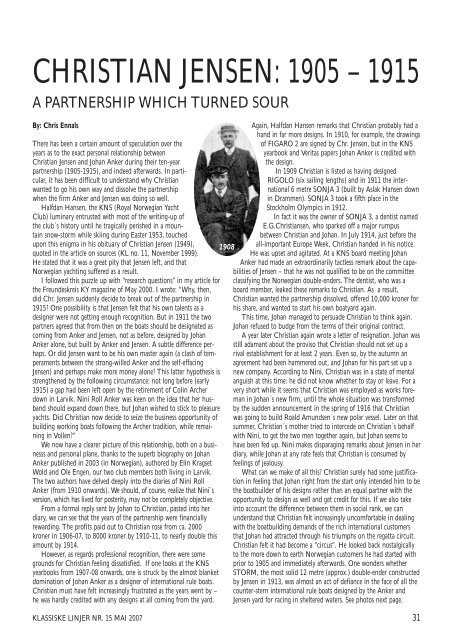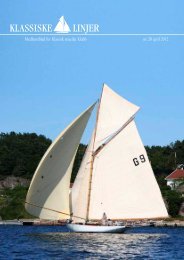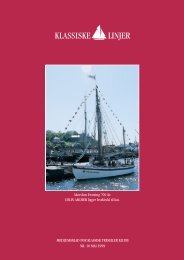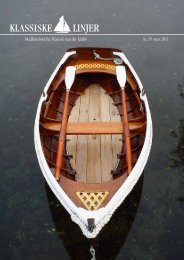Klassiske Linjer nr 15 mai 2007 - Klassisk Treseiler Klubb
Klassiske Linjer nr 15 mai 2007 - Klassisk Treseiler Klubb
Klassiske Linjer nr 15 mai 2007 - Klassisk Treseiler Klubb
Create successful ePaper yourself
Turn your PDF publications into a flip-book with our unique Google optimized e-Paper software.
CHRISTIAN JENSEN: 1905 – 19<strong>15</strong><br />
A PARTNERSHIP WHICH TURNED SOUR<br />
By: Chris Ennals<br />
There has been a certain amount of speculation over the<br />
years as to the exact personal relationship between<br />
Christian Jensen and Johan Anker during their ten-year<br />
partnership (1905-19<strong>15</strong>), and indeed afterwards. In particular,<br />
it has been difficult to understand why Christian<br />
wanted to go his own way and dissolve the partnership<br />
when the firm Anker and Jensen was doing so well.<br />
Halfdan Hansen, the KNS (Royal Norwegian Yacht<br />
Club) luminary entrusted with most of the writing-up of<br />
the club´s history until he tragically perished in a mountain<br />
snow-storm while skiing during Easter 1953, touched<br />
upon this enigma in his obituary of Christian Jensen (1949),<br />
quoted in the article on sources (KL no. 11, November 1999).<br />
He stated that it was a great pity that Jensen left, and that<br />
Norwegian yachting suffered as a result.<br />
I followed this puzzle up with “research questions” in my article for<br />
the Freundeskreis KY magazine of May 2000. I wrote: “Why, then,<br />
did Chr. Jensen suddenly decide to break out of the partnership in<br />
19<strong>15</strong>? One possibility is that Jensen felt that his own talents as a<br />
designer were not getting enough recognition. But in 1911 the two<br />
partners agreed that from then on the boats should be designated as<br />
coming from Anker and Jensen, not as before, designed by Johan<br />
Anker alone, but built by Anker and Jensen. A subtle difference perhaps.<br />
Or did Jensen want to be his own master again (a clash of temperaments<br />
between the strong-willed Anker and the self-effacing<br />
Jensen) and perhaps make more money alone? This latter hypothesis is<br />
strengthened by the following circumstance: not long before (early<br />
19<strong>15</strong>) a gap had been left open by the retirement of Colin Archer<br />
down in Larvik. Nini Roll Anker was keen on the idea that her husband<br />
should expand down there, but Johan wished to stick to pleasure<br />
yachts. Did Christian now decide to seize the business opportunity of<br />
building working boats following the Archer tradition, while re<strong>mai</strong>ning<br />
in Vollen?”<br />
We now have a clearer picture of this relationship, both on a businesss<br />
and personal plane, thanks to the superb biography on Johan<br />
Anker published in 2003 (in Norwegian), authored by Elin Kragset<br />
Wold and Ole Engen, our two club members both living in Larvik.<br />
The two authors have delved deeply into the diaries of Nini Roll<br />
Anker (from 1910 onwards). We should, of course, realize that Nini´s<br />
version, which has lived for posterity, may not be completely objective.<br />
From a formal reply sent by Johan to Christian, pasted into her<br />
diary, we can see that the years of the partnership were financially<br />
rewarding. The profits paid out to Christian rose from ca. 2000<br />
kroner in 1906-07, to 8000 kroner by 1910-11, to nearly double this<br />
amount by 1914.<br />
However, as regards professional recognition, there were some<br />
grounds for Christian feeling dissatisfied. If one looks at the KNS<br />
yearbooks from 1907-08 onwards, one is struck by the almost blanket<br />
domination of Johan Anker as a designer of international rule boats.<br />
Christian must have felt increasingly frustrated as the years went by –<br />
he was hardly credited with any designs at all coming from the yard.<br />
KLASSISKE LINJER NR. <strong>15</strong> MAI <strong>2007</strong><br />
1908<br />
Again, Halfdan Hansen remarks that Christian probably had a<br />
hand in far more designs. In 1910, for example, the drawings<br />
of FIGARO 2 are signed by Chr. Jensen, but in the KNS<br />
yearbook and Veritas papers Johan Anker is credited with<br />
the design.<br />
In 1909 Christian is listed as having designed<br />
RIGOLO (six sailing lengths) and in 1911 the international<br />
6 metre SONJA 3 (built by Aslak Hansen down<br />
in Drammen). SONJA 3 took a fifth place in the<br />
Stockholm Olympics in 1912.<br />
In fact it was the owner of SONJA 3, a dentist named<br />
E.G.Christiansen, who sparked off a major rumpus<br />
between Christian and Johan. In July 1914, just before the<br />
all-important Europe Week, Christian handed in his notice.<br />
He was upset and agitated. At a KNS board meeting Johan<br />
Anker had made an extraordinarily tactless remark about the capabilities<br />
of Jensen – that he was not qualified to be on the committee<br />
classifying the Norwegian double-enders. The dentist, who was a<br />
board member, leaked these remarks to Christian. As a result,<br />
Christian wanted the partnership dissolved, offered 10,000 kroner for<br />
his share, and wanted to start his own boatyard again.<br />
This time, Johan managed to persuade Christian to think again.<br />
Johan refused to budge from the terms of their original contract.<br />
A year later Christian again wrote a letter of resignation. Johan was<br />
still adamant about the proviso that Christian should not set up a<br />
rival establishment for at least 2 years. Even so, by the autumn an<br />
agreement had been hammered out, and Johan for his part set up a<br />
new company. According to Nini, Christian was in a state of mental<br />
anguish at this time: he did not know whether to stay or leave. For a<br />
very short while it seems that Christian was employed as works foreman<br />
in Johan´s new firm, until the whole situation was transformed<br />
by the sudden announcement in the spring of 1916 that Christian<br />
was going to build Roald Amundsen´s new polar vessel. Later on that<br />
summer, Christian´s mother tried to intercede on Christian´s behalf<br />
with Nini, to get the two men together again, but Johan seems to<br />
have been fed up. Nini makes disparaging remarks about Jensen in her<br />
diary, while Johan at any rate feels that Christian is consumed by<br />
feelings of jealousy.<br />
What can we make of all this? Christian surely had some justification<br />
in feeling that Johan right from the start only intended him to be<br />
the boatbuilder of his designs rather than an equal partner with the<br />
opportunity to design as well and get credit for this. If we also take<br />
into account the difference between them in social rank, we can<br />
understand that Christian felt increasingly uncomfortable in dealing<br />
with the boatbuilding demands of the rich international customers<br />
that Johan had attracted through his triumphs on the regatta circuit.<br />
Christian felt it had become a ”circus”. He looked back nostalgically<br />
to the more down to earth Norwegian customers he had started with<br />
prior to 1905 and immediately afterwards. One wonders whether<br />
STORM, the most solid 12 metre (approx.) double-ender constructed<br />
by Jensen in 1913, was almost an act of defiance in the face of all the<br />
counter-stern international rule boats designed by the Anker and<br />
Jensen yard for racing in sheltered waters. See photos next page.<br />
31






